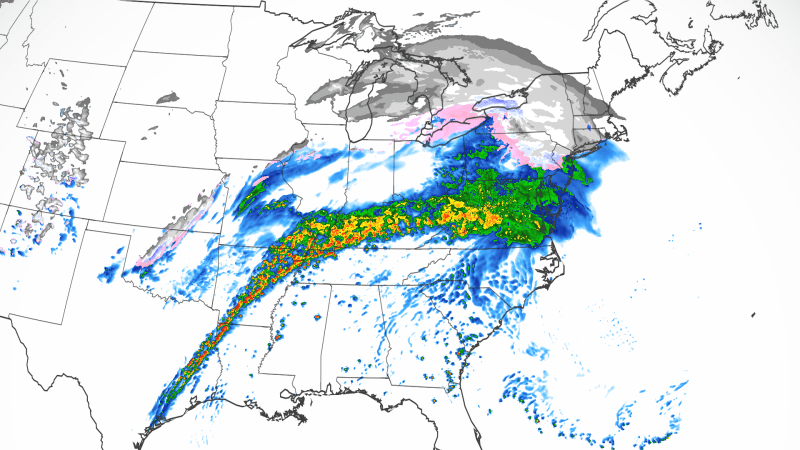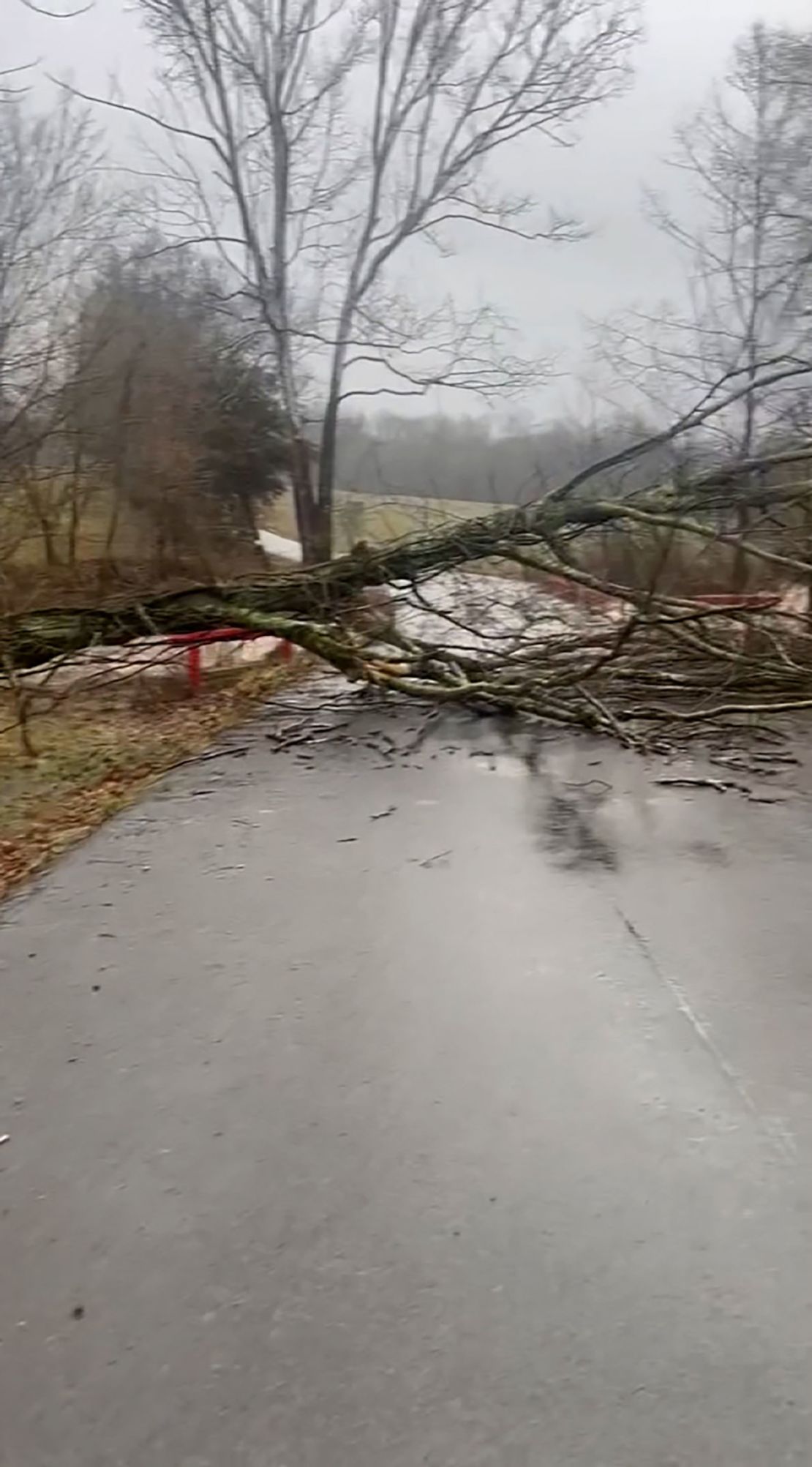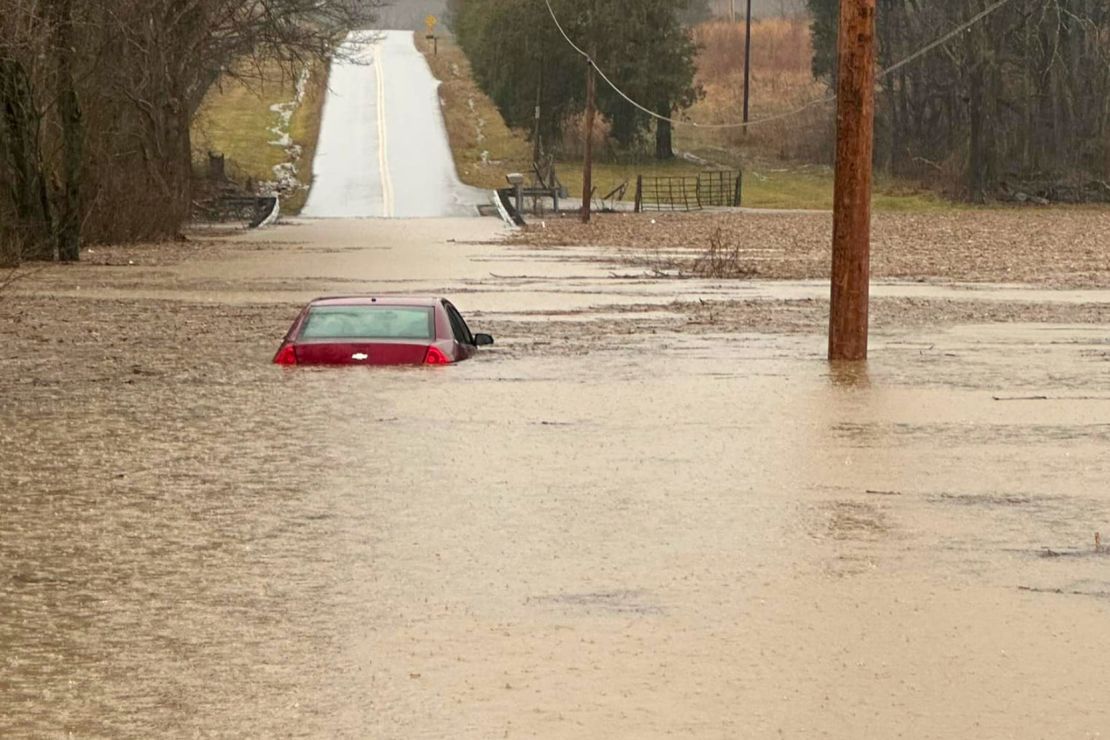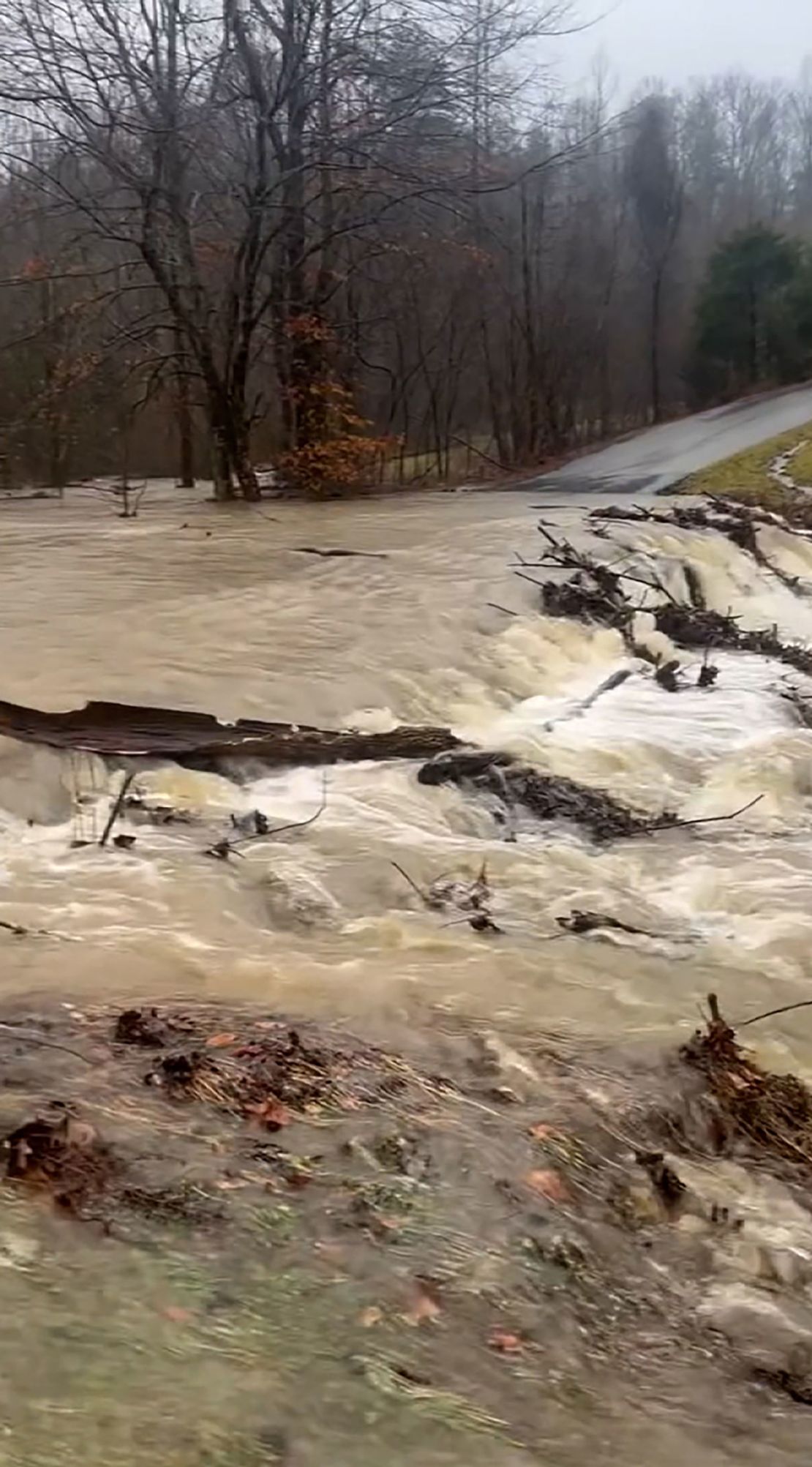
CNN —
A devastating storm is currently wreaking havoc across the eastern United States, resulting in severe flooding that has claimed at least one life, led to emergency evacuations, and caused extensive road closures and hazardous travel conditions in multiple states.
A 73-year-old man from Manchester, Kentucky, tragically lost his life after floodwaters swept him away when he exited his vehicle in the Horse Creek area on Saturday night, as reported by the Clay County Coroner’s Office.
Flash flood emergencies and warnings were activated for hundreds of thousands in states including West Virginia, Virginia, Kentucky, Arkansas, and Tennessee throughout Saturday night. In Virginia alone, at least 413,000 individuals faced a flood threat that could inflict “considerable damage.”
Tornado warnings emerged across Mississippi, West Tennessee, and Southeast Arkansas on Saturday evening, with a large tornado watch in effect overnight across much of Mississippi and Alabama.
In Virginia, over 19,000 homes and businesses experienced power outages by Saturday night, according to poweroutage.us. Additionally, more than 16,000 customers were left without power in Kentucky and Louisiana.
Heavy rainfall is battering various regions in Virginia, with flash floods reported in the southwestern part of the state. Governor Glenn Youngkin noted that some locales saw between 1.5 to 3 inches of rain, with an additional 0.5 to 1.5 inches possible.
“Stay alert—do not engage with floodwaters; evacuate and seek assistance,” Youngkin advised the public.
Officials are advising residents to evacuate flooded regions immediately and to reach out for assistance if necessary, with first responders, law enforcement, and the Virginia National Guard on standby to ensure the safety of the public.
As flooding severely impacted Kentucky, Kentucky Route 160 in Knott County was closed due to a landslide. Some residents in Perry County were evacuated, and historical water levels were reported in Hardin County, as stated by Governor Andy Beshear. In Jackson, significant flooding occurred as the 75-acre Panbowl Lake overflowed, prompting evacuation measures for nursing homes and hospitals, as revealed in statements from officials on Saturday night.

“Kentucky is currently facing widespread flooding, and it’s imperative that everyone treats this situation with the utmost seriousness,” said Beshear in a statement. “Please ensure that you can receive weather alerts, keep radios on, and be prepared to seek higher ground if needed.”
In anticipation of the storm, Beshear had declared a state of emergency on Friday. Shelters are being set up for those who evacuated, and Kentucky State Police are conducting welfare checks, he announced Saturday evening.
By Saturday afternoon, various streets in Kentucky were already inundated, with parks resembling lakes. Water levels are anticipated to continue rising through the evening, with some areas reporting between 2 to 4 inches of rain by that time.

“The heavy rainfall is causing significant flooding in our region, and our storm sewer system is currently operating at full capacity,” stated the City of Bowling Green on X Saturday. “If possible, please avoid traveling today to ensure your safety as well as that of others.”
Floodwaters surged through several streets across Simpson County, Kentucky. At one point, a stalled vehicle was pushed away by the rising waters, according to the county’s emergency management office. In response, “road closed” signs and barricades were erected, and residents were strongly advised to remain indoors.
Authorities in the city of Manchester are responding to numerous water rescue operations, reported the police department on Saturday afternoon.
Additionally, dozens of roads in Adair County were reported closed due to flooding, according to emergency management officials.
The persistent heavy rain can also lead to additional hazards such as fallen trees and landslides, as warned by the Kentucky Transportation Cabinet earlier today.

Kentucky is once again grappling with historic flooding, just two years after devastating floods resulted in 43 fatalities and destroyed numerous areas within the state.
The torrential flooding has resulted in the loss of homes, submerged vehicles, and the destruction of vital businesses and infrastructure vital for water and electricity services. The aftermath has left thousands of residents displaced.
With memories of the severe flooding that devastated his home in 2022 still fresh, Knott County resident Danny Laferty expresses his anxiety about potentially losing everything once again.
“It was catastrophic; we had mud several inches deep everywhere,” Laferty shared with CNN on Saturday. “This uncertainty makes me extremely uneasy.”
Laferty is still in the process of repairing his flood-damaged home and recalls the traumatic experience of evacuating with his grandchildren and dogs during the crisis.
“It’s challenging for my wife and extremely difficult for me as well. The hard work and heartache are overwhelming,” he explained.
While Laferty has grown accustomed to flooding in his area, he asserts that the nature and severity of the recent floods in eastern Kentucky have changed significantly.
“I find it hard to comprehend how floods can reach such extreme levels,” he remarked.
The severe storm that has already caused extensive flooding in parts of California is now delivering significant rain and severe thunderstorms to the eastern U.S., potentially leading to flash floods, snow, and ice over the weekend. Snowfall has been reported in the Great Lakes region, while regions to the south, including parts of the Ohio Valley, are experiencing intense rainfall and thunderstorms.
The storm is intensifying on Saturday and is expected to reach its peak overnight into Sunday as it sweeps through a large portion of the eastern United States. The storm’s impact will lessen by Monday, although localized lake-effect snow could accumulate in some areas of the Great Lakes.
Heavy rainfall causing widespread flooding is the primary threat from this storm, with the majority of it falling on Saturday.
An extensive area stretching over 1,200 miles from the Gulf Coast to the Northeast could be at risk of flooding, with many locations expecting over 2 inches of rain.
Certain locations may experience even higher totals.
A rare level 4 of 4 high risk for flooding is in effect for over 1.5 million people in parts of northwestern Tennessee and western Kentucky, where “potentially life-threatening significant flooding is predicted,” according to the Weather Prediction Center. Additionally, more than 500 miles stretching from eastern Arkansas to West Virginia fall under a level 3 of 4 flooding risk this Saturday, as outlined by the center.
“Expect a significant, potentially historic flash flood event this afternoon and evening,” the National Weather Service in Paducah, Kentucky, warned on Saturday morning.
The prolonged rainfall event started before dawn and has already triggered flash flood warnings in Tennessee and Kentucky, with the worst flooding anticipated in the early afternoon to evening.
It cannot be overstated how serious these situations are. Such warnings are issued less than 4% of days within a year but are responsible for over 80% of flood-related damages and 40% of flood-related fatalities, according to research from the Weather Prediction Center.
The elevated threat level is attributed to an unusual atmospheric setting for mid-February, which could support rainfall rates reaching 2 inches per hour during the most intense storms, as indicated by the center. In high-risk areas, half a foot of rainfall may accumulate as heavier rains linger for an extended time.
Practically no region will effectively absorb such an enormous amount of rain without experiencing flooding; the recent storms have already saturated the soils in this area, exacerbating the threat significantly.
Severe thunderstorms are developing south of the areas receiving the heaviest rain on Saturday, posing an additional risk. The Storm Prediction Center has issued a level 3 of 5 risk for severe thunderstorms across parts of Louisiana, Arkansas, Mississippi, Tennessee, and Alabama.
These storms are capable of producing damaging winds and tornadoes, particularly from late Saturday afternoon into the overnight hours.
Any severe thunderstorm on Saturday has the potential to produce a tornado, but those in the level 3 of 5 risk area—especially in Mississippi—are at a heightened risk for strong tornadoes rated EF2 or higher.
EF2 tornadoes can generate winds between 111-135 mph, capable of tearing roofs off buildings and shifting them from their foundations.
The most intense storms are expected to occur after dark, which increases their danger level. Tornadoes are difficult to detect at night, making it more challenging for people to react, even if they are awake and alerted by warnings.
Nighttime tornadoes are reported to be twice as deadly as those occurring during daylight hours, a finding supported by a study in 2022. Just last week, a tornado that struck a Tennessee community after dark resulted in at least two fatalities.
Some severe thunderstorms are likely to continue into Sunday morning, bringing damaging winds from Florida all the way up to the mid-Atlantic region.
Upcoming Snow and Ice
The storm will produce snow and ice on its colder northern side while heavy rain and severe thunderstorms affect the warmer areas.
Snow is currently falling over the Great Lakes and is expected to spread into the Northeast. Areas in the Ohio Valley are experiencing icy conditions, with snow likely to reach more of the Northeast Saturday afternoon before transitioning to a mix of snow, sleet, and freezing rain as warmer air moves in later tonight.
This hazardous mix is predicted to affect much of New York State and New England overnight into Sunday while the storm is at its peak intensity.
Strong winds are expected to sweep across the Northeast, potentially causing power outages, especially in regions experiencing both snow and ice. Travel is likely to be treacherous in affected zones.
Snow totals could reach double digits in regions of the Great Lakes, northern New York, and northern New England over the weekend. Areas just south of the most intense snow may receive reduced totals due to mixing with ice and sleet, particularly in the Ohio Valley and southern parts of the Northeast.
Lake-effect snow is anticipated to occur across the Great Lakes following the storm’s passage on Monday.
Following the storm, a new wave of frigid air is expected to settle over much of the U.S., causing temperatures to plummet more than 30 degrees below normal in various central regions early next week.









